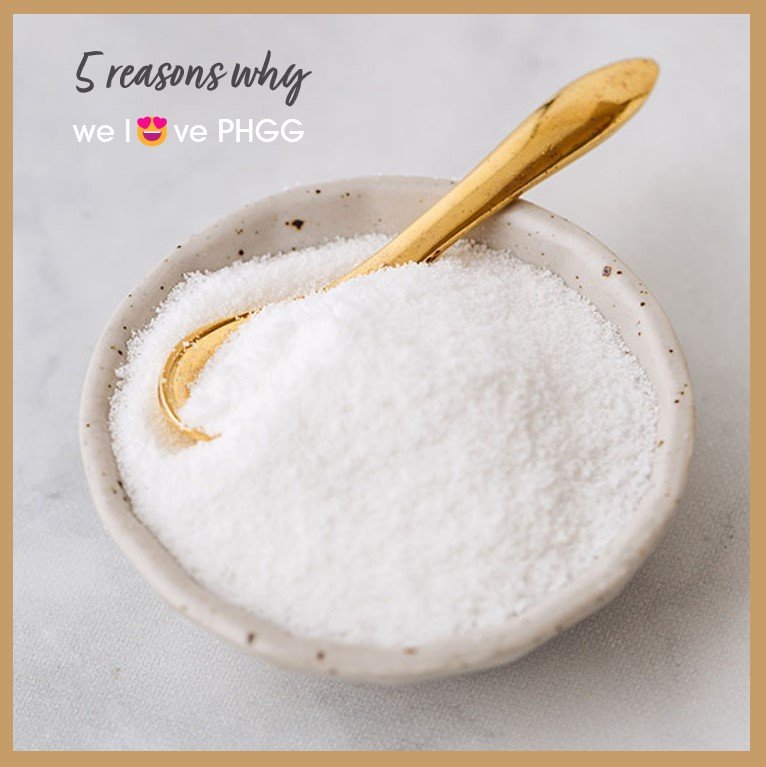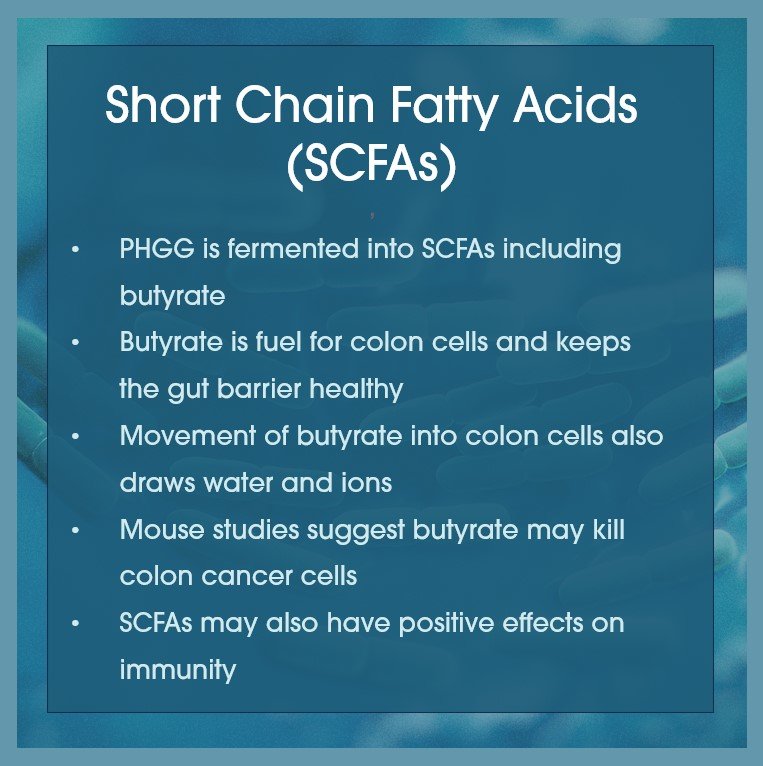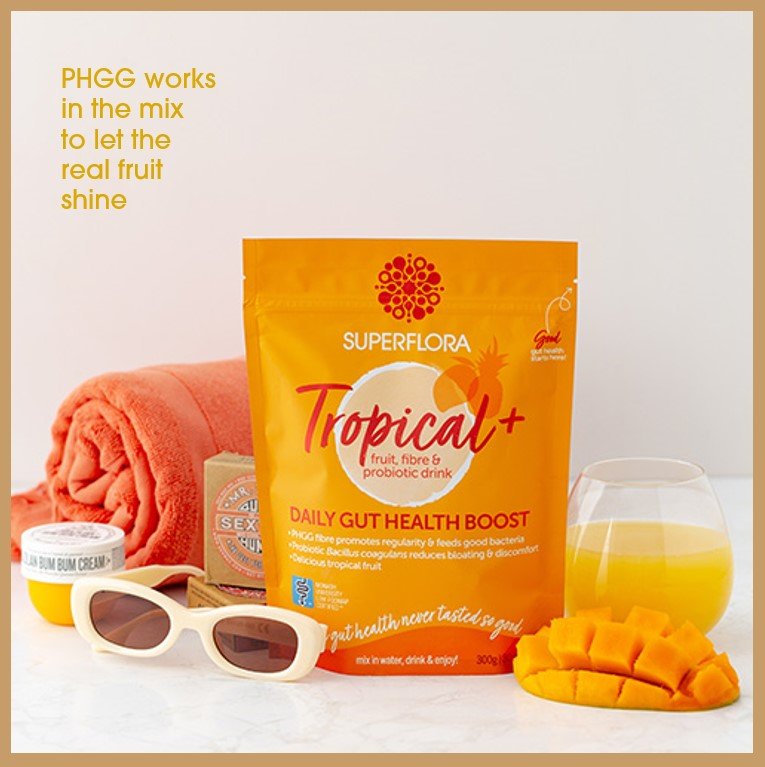5 reasons to love PHGG prebiotic fibre
This month’s blog provides 5 reasons to love the prebiotic fibre PHGG, plus a behind the scenes look at how a new product is born.
A few years ago after a colonoscopy my gastroenterologist recommended a well-known fibre supplement to help keep me regular and minimize straining.
I gave it a try, and whilst it mixed easily in water and did the job, I also experienced bad tummy pains, not something I wanted daily.
I tried another brand, but with this one I struggled with its strong artificial flavour, yuck!.
It turns out I’m not the only one needing to add fibre to my diet. Getting enough fibre can be especially hard for people on a gluten-free or low fodmap diet. Which is one reason why Josephine and I put together our Superflora shakes with a blend of 5 different fibre sources adding up to a whopping 7g of fibre per serve. Finally! I had a great source of fibre that my tummy and tastebuds actually enjoyed. Happy days.
Our shakes are substantial and filling. I love them blitzed with milk and fruit or peanut butter for breakfast or lunch.
In the back of my mind though I wondered if we could also develop something similar to those products that I’d previously tried…just without the tummy pains or yucky artificial flavours and colours.
We wanted something that could be simply stirred in water as a quick option when you don’t want a shake, something that worked as an easy and enjoyable morning gut health ritual.
The idea for our Daily Gut Health Boosts was born. Along with the PHGG prebiotic fibre, we’d add in a probiotic too and flavour them with the real fruit powders we’d discovered when developing our shakes. We’d make them so delicious that you’d actually look forward to having them daily.
The question then was: what fibre type to use? It had to be gluten-free and low-fodmap, and also have good clinical evidence for its gut health benefits.
We looked again at the fibre sources in our shakes and also talked to manufacturers of some new functional fibres, including one very hush, hush blend that isn’t even in the market yet.
We did plenty of taste testing and some reading. Partially hydrolysed guar gum (PHGG) made from guar beans looked promising.
The next step was for me to put on my scientist’s hat, and dive into the medical databases to search for papers and conduct a full systematic literature review. I collated data from 24 clinical studies on PHGG conducted from 1994 to 2022 and also looked at background lab studies. Is it as good as we thought?
Yes, it turns out that it is pretty special. There is a wealth of human trials from across the globe demonstrating that PHGG improves gut health and also influences the gut microbiome and its metabolites. Plus, animal and lab studies that help explain why.
Here’s a summary of what I found, AKA five reasons to love PHGG. Ready on and find out what PHGG is good for. And if you want to dive deeper, there are references at the bottom of the page.
1) PHGG promotes regularity and digestive balance
PHGG normalises stool consistency and regularises the rate of movement of contents through the gut improving symptoms of both constipation AND diarrhoea.
PHGG for Diarrhoea
Several studies have demonstrated that PHGG can help reduce the duration of diarrhoea, even in severe cases. For example, a randomized clinical trial conducted in Dhaka Hopsital in Bangladesh (Alam et al. 2015) demonstrated that adding PHGG to oral rehydration fluid reduces the duration of diarrhoea in babies and young children admitted suffering from prolongued watery diarrhoea.
A study by Da Silva et al. (2022) demonstrated that PHGG extends the time it takes for food to move through the small intestine, which may help explain how PHGG reduces diarrhoea.
PHGG for Constipation
A Greek study published in 2014 investigated the effect of just 5g of PHGG a day for adults with chronic constipation (Polymeros et al. 2014). The investigators measured colon transit time (the time for food to move through the large intestine) and constipation symptoms. They found that 4 weeks of PHGG accelerated colon transit time and improved symptoms including frequency of bowel movements, laxative use and days with abdominal pain.
Bowel motility tends to slow down as we age and many older people use laxatives to treat constipation. I found a couple of studies investigating the effects of PHGG in this group. For example, a recent randomized control trial in a long term care facility for the elderly in Hong Kong (Chan et al. 2022) looked at the effects of drinking 5g of PHGG dissolved in water per day. After 3 - 4 weeks, the PHGG group needed significantly less laxatives than the control group.
PHGG and Irritable Bowel Syndrome
PHGG helps to normalise stool form and frequency in IBS patients too. An Italian study (Russo et al. 2015) conducted with participants who had the constipation predominant form of IBS, found that stool form, colon transit time and laxative use improved with PHGG.
Similarly a 3 month long, Japanese, randomised clinical trial (Yasukawa et al. 2019) that included participants with diarrhoea predominant IBS also found that 5g of PHGG daily led to a normalisation of the stool form – (helping participants get closer to 4 on the Bristol Stool Chart).
2) Less gas and bloating
One of most positive things about these studies is that PHGG promotes regularity without causing painful bloating unlike some other fibre sources.
PHGG is slowly fermented in the large intestine and thus does not lead to a rapid build up of gas. For example, the Greek researchers mentioned above (Polymeros et al. 2014) found that PHGG reduced bloating and gaseousness as well as constipation.
Similarly, a study of IBS patients (Parisi et al. 2002) comparing fibre supplementation with wheat bran or PHGG found that improvements in abdominal pain and bowel habits were observed with both bran and PHGG, but the PHGG was better tolerated and preferred by study participants.`
3) Feeds good bacteria
PHGG acts as a prebiotic (source of energy and nutrients) for beneficial bacteria. This does two things:
PHGG fermentation leads to production of beneficial metabolites
In the longer term, PHGG changes the diversity and balance of the microbiome in a positive way.
PHGG helps to promote healthy bacteria, including Lactobacilli and Bifidobacteria (Reider et al. (2020); Miyoshi et al. (2020); Takahashi et al (1994)).
Lab studies have indicated that PHGG is not used directly by these bacteria, instead it appears that PHGG is degraded in the human colon providing substrates that favour the selective growth of Bifidobacteria and Lactobacilli (Yusukawa et al., (2019), and Giannini et al., (2006)).
4) PHGG fermentation by the microbiome results in short-chain fatty acids
As I mentioned above, good gut bacteria turn PHGG into beneficial metabolites.
I found two recent studies demonstrating that consuming PHGG increases production of short-chain fatty acids SCFAs by the microbiome (Miyoshi et al. (2020) and Sakai et al. (2022)).
The SCFAs (butyrate, acetate and propionate) have a multitude of effects. The SCFAs provide fuel for colonocytes – the cells lining the colon. This helps them proliferate and maintain the gut barrier.
Uptake of SCFAs by the colonocytes also affects movement of water and ions across the colon lining (Roediger et al. (1984) and Binder et al. (1989)). This is likely to be especially important in aiding recovery from severe diarrhoea (Alam et al. 2015).
There is growing evidence for other possible benefits associated with SCFAs, including effects on inflammation and heart health. See our blog on cholesterol lowering effects of PHGG here.
The study by Sakai et al. (2022) also suggests that PHGG intake may improve immune function and suppress cold-like symptoms through increased production of SCFAs.
5) Finally, we love PHGG because of what it doesn’t have
PHGG is pretty much flavourless and dissolves easily in water. That means that we can mix it with fabulous real fruit powders to make our three Daily Gut Health Boost drinks and it lets the fruit shine.
Taste testing different fruit and greens combos, was certainly the best part of the product development process, except perhaps for experimenting with kale and brocolli powders. You’ll notice they did NOT make the final cut! In the end we came up with three delicious flavours:
Berries+ with real strawberries, raspberries, acai berry and kiwi fuit.
Citrusy Greens+ with real lemon, lime, kiwi fruit, spinach, chlorella and spirulina, and
Tropical+ with a cocktail of mango, papapya, passionfruit, pineapple, blood orange and carrot juice powder.
You simply stir 10g in ½ a cup of chilled water to make a beautiful drink.
The Boosts don’t contain any synthetic flavours or sweeteners. They are gluten-free and we carefully worked on the recipes to keep them low-FODMAP at the recommended serving size. A single serve provides the 5g of PHGG the clinical studies recommend, plus 1 billion CFU of our probiotic and a powerful fruity flavour.
Most of the studies described above lasted from a few weeks to a few months. Consistency appears to pay off with PHGG. Benefits built steadily and then waned once participants stopped taking the PHGG.
It’s best to develop a daily gut ritual of having a Boost before breakfast and stick with it. We recommend having it first thing in the morning, because this was the protocol used in many of the clinical studies, but there is no clear evidence about the best time to take PHGG. Have it at a time that fits into your routine and then you’ll stick with it.
Enjoy!
Written by: Dr Mary Webberley, Chief Scientific Officer at Noisy Guts. Mary has a background in biology, with two degrees from the University of Cambridge and post-doctoral research experience. She spent several years undertaking research into the diagnosis of IBS and IBD. She was the winner of the 2018 CSIRO Breakout Female Scientist Award.
References:
Alam, N. H., Ashraf, H., Kamruzzaman, M., Ahmed, T., Islam, S., Olesen, M. K., Gyr, N., & Meier, R. (2015). Efficacy of partially hydrolyzed guar gum (PHGG) supplemented modified oral rehydration solution in the treatment of severely malnourished children with watery diarrhoea: a randomised double-blind controlled trial. Journal of health, population, and nutrition, 34, 3. https://doi.org/10.1186/s41043-015-0003-3
Binder, H. J., & Mehta, P. (1989). Short-chain fatty acids stimulate active sodium and chloride absorption in vitro in the rat distal colon. Gastroenterology, 96(4), 989–996. https://doi.org/10.1016/0016-5085(89)91614-4
Chan, T. C., Yu, V. M. W., Luk, J. K. H., Chu, L. W., Yuen, J. K. Y., & Chan, F. H. W. (2022). Effectiveness of Partially Hydrolyzed Guar Gum in Reducing Constipation in Long Term Care Facility Residents: A Randomized Single-Blinded Placebo-Controlled Trial. The journal of nutrition, health & aging, 26(3), 247–251. https://doi.org/10.1007/s12603-022-1747-2
da Silva, M. V. T., Nunes, S. S., Costa, W. C., Sanches, S. M. D., Silveira, A. L. M., Ferreira, Á. R. S., Filha, R. S., Correia, M. I. T. D., Mota, L. D. G., & Generoso, S. V. (2022). Acute intake of fructooligosaccharide and partially hydrolyzed guar gum on gastrointestinal transit: A randomized crossover clinical trial. Nutrition (Burbank, Los Angeles County, Calif.), 102, 111737. https://doi.org/10.1016/j.nut.2022.111737
Giannini, E. G., Mansi, C., Dulbecco, P., & Savarino, V. (2006). Role of partially hydrolyzed guar gum in the treatment of irritable bowel syndrome. Nutrition, 22(3), 334–342. https://doi.org/10.1016/j.nut.2005.10.003
Miyoshi, M., Shiroto, A., Kadoguchi, H., Usami, M., & Hori, Y. (2020). Prebiotics Improved the Defecation Status via Changes in the Microbiota and Short-chain Fatty Acids in Hemodialysis Patients. The Kobe journal of medical sciences, 66(1), E12–E21.
Parisi, G. C., Zilli, M., Miani, M. P., Carrara, M., Bottona, E., Verdianelli, G., Battaglia, G., Desideri, S., Faedo, A., Marzolino, C., Tonon, A., Ermani, M., & Leandro, G. (2002). High-fiber diet supplementation in patients with irritable bowel syndrome (IBS): a multicenter, randomized, open trial comparison between wheat bran diet and partially hydrolyzed guar gum (PHGG). Digestive diseases and sciences, 47(8), 1697–1704. https://doi.org/10.1023/a:1016419906546
Polymeros, D., Beintaris, I., Gaglia, A., Karamanolis, G., Papanikolaou, I. S., Dimitriadis, G., & Triantafyllou, K. (2014). Partially hydrolyzed guar gum accelerates colonic transit time and improves symptoms in adults with chronic constipation. Digestive diseases and sciences, 59(9), 2207–2214. https://doi.org/10.1007/s10620-014-3135-1
Reider, S. J., Moosmang, S., Tragust, J., Trgovec-Greif, L., Tragust, S., Perschy, L., Przysiecki, N., Sturm, S., Tilg, H., Stuppner, H., Rattei, T., & Moschen, A. R. (2020). Prebiotic Effects of Partially Hydrolyzed Guar Gum on the Composition and Function of the Human Microbiota-Results from the PAGODA Trial. Nutrients, 12(5), 1257. https://doi.org/10.3390/nu12051257
Roediger, W. E., & Moore, A. (1981). Effect of short-chain fatty acid on sodium absorption in isolated human colon perfused through the vascular bed. Digestive diseases and sciences, 26(2), 100–106. https://doi.org/10.1007/BF01312224
Russo, L., Andreozzi, P., Zito, F. P., Vozzella, L., Savino, I. G., Sarnelli, G., & Cuomo, R. (2015). Partially hydrolyzed guar gum in the treatment of irritable bowel syndrome with constipation: effects of gender, age, and body mass index. Saudi journal of gastroenterology : official journal of the Saudi Gastroenterology Association, 21(2), 104–110. https://doi.org/10.4103/1319-3767.153835
Sakai, S., Kamada, Y., Takano, H., Ichikawa, M., Kurimoto, M., Katsuyama, H. K., Nishihira, J., & Sasaki, M. (2022). Continuous partially hydrolyzed guar gum intake reduces cold-like symptoms: a randomized, placebo-controlled, double-blinded trial in healthy adults. European review for medical and pharmacological sciences, 26(14), 5154–5163. https://doi.org/10.26355/eurrev_202207_29304
Takahashi, H., Wako, N., Okubo, T., Ishihara, N., Yamanaka, J., & Yamamoto, T. (1994). Influence of partially hydrolyzed guar gum on constipation in women. Journal of nutritional science and vitaminology, 40(3), 251–259. https://doi.org/10.3177/jnsv.40.251
Yasukawa, Z., Inoue, R., Ozeki, M., Okubo, T., Takagi, T., Honda, A., & Naito, Y. (2019). Effect of Repeated Consumption of Partially Hydrolyzed Guar Gum on Fecal Characteristics and Gut Microbiota: A Randomized, Double-Blind, Placebo-Controlled, and Parallel-Group Clinical Trial. Nutrients, 11(9), 2170. https://doi.org/10.3390/nu11092170






